Walt Disney Productions (November 25, 1992), Walt Disney Home Entertainment (October 5, 2004), 2 disc set, 90 mins plus supplements, 1.66:1 original widescreen ratio, Dolby Digital 5.1 Surround and 5.1 Disney Enhanced Home Theater Mix, Rated G, Retail: $29.99
Storyboard:
A street urchin named Aladdin, and his pet monkey Abu, get involved in a plot to retrieve a special lamp hidden deep inside a mysterious cave. With the lamp, Aladdin gets to fulfill his wishes of becoming free from the trappings of his social class and finding his true love.
The Sweatbox Review:
Aladdin was probably the first film I was ever completely obsessed with as a kid. I had been counting down the months and days from the first time I saw the theatrical trailer to the day it came to big screens in town. I was so excited about this film that I wanted to know everything about it. This was probably the first time I actually started reading news about the making of the film. I specifically remember reading a magazine article on the visuals of the film (although I probably got half of it). For many on that fateful day in November of 1992, it was probably an afternoon like many others, but for me it was filled with excitement and anticipation. From the opening frames of the movie with its memorable (some would say hypnotic) score and stunningly beautiful visuals, I was captivated. As the words Aladdin came up on the screen, I felt chills going down my back. I distinctly remember I went with my father who also really seemed to enjoy the film. My favorite character was, of course, the Genie, and when I came home that day I was already trying to recall all the words to “Friend Like Me” and “Prince Ali.” Still, it was only years later when my VHS copy got lost in the mail that I realized the impact the movie had on me. I love this movie, and it is still one of my favorite films of all time, so I was thrilled to finally own it.
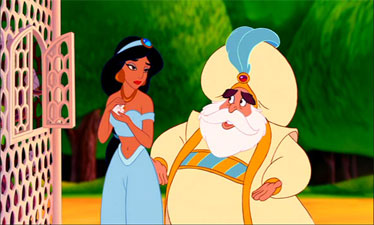
While I would like to think that this movie is mine in some form, I realize now that this movie didn’t just have an impact on a few kids, but on my entire generation. It is probably, along with the other “Fab Four”, the most influential film and one of the favorites for many people. People fondly remember the film, the music, the characters, and the humor that made it so special. When the film was released in 1992, expectations were high. Beauty & the Beast, which had been released just a year prior to Aladdin, had grossed $145 million and earned an Academy Award nomination for Best Picture. Aladdin was also produced by the same team that had turned The Little Mermaid into such a successful project for Disney, co-directors John Musker and Ron Clemens, with music by the Academy Award-winning musicians Alan Menken and Howard Ashman (who passed away in 1991). When the movie finally came out, critics were kind, but the public adored the movie. It went on to make $217 million domestically, for a total of $479 million worldwide. The movie also went on to earn 5 Academy Award nominations and won for Best Song and Score.
Disney had already been deep into the VHS age when Aladdin came out, and they were experiencing a boom in business with their old and new films. In fact, trailers for the Aladdin theatrical release were featured in copies of Beauty & the Beast which had sold extremely well. When Aladdin finally came out on home video in 1993, it quickly became one of the best-selling videos of all time with twenty-four million copies sold. It would later spawn two direct-to-video sequels (the first of their kind for Disney), The Return of Jafar (1994) and Aladdin and the King of Thieves (1996). The Return of Jafar sold seven million copies and became one of the ten best-selling videos of all time. The movie would also pave the way for the popular Aladdin television show that ran for 86 episodes between 1994 and 1995. With the DVD age, Disney had lavish plans for Aladdin, which this year had been out of print since its first VHS release. Snow White, Beauty & The Beast, and The Lion King paved the way with their perspective Platinum Editions for Aladdin’s release in October of 2004. If history repeats itself, this will become one of the best-selling DVDs of the year.
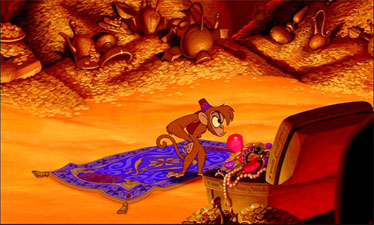
The story of a boy named Aladdin has its roots in the classical collection of tales, One Thousand And One Nights, from India, Persia, and Arabia. In this collection Sheherazade had to tell a different story every night for her husband so that he would keep her alive. One of the stories was about a young street urchin who fell in love with a princess and disguised himself as a prince with the help of a genie. The story was later translated (and edited) from the Arabic in the early 1700s by French writer and translator Antoine Galland who called them Arabian Nights. Aladdin was later made popular by English writer Richard Burton in the 19th century. Needless to say, the story had been popular for over five hundred years when development started at Disney. By 1988, lyricist Howard Ashman wrote the first draft of the script and development had started. John Musker and Ron Clemens, the directors of The Little Mermaid, soon joined in the project that would see many changes until its release in 1992.
The story starts out with a narrator telling the story of Jafar, the sultan’s vizier, who wants a magic lamp so that he can become Sultan. He finds out that only a “diamond in the rough” can enter a secret cave. Meanwhile, in the city of Agrabah, a young street urchin named Aladdin and his pet monkey, Abu, dream of one day proving to other people that there is more to them than others think. At the Palace, the Sultan is worried about finding his daughter a suitable husband, who has to be a prince. However, Princess Jasmine refuses all suitors who have come to claim her, and she wants to marry someone for love. One day, when Princess Jasmine escapes the palace in disguise, she runs into Aladdin who saves her. Unfortunately, Aladdin is arrested for kidnapping the Princess and condemned to die before Jasmine can save him. Jafar finds out that Aladdin is the so-called “diamond in the rough” and uses him to bring him the lamp. In the Cave of Wonders, he finds the lamp, but is trapped inside. This is when he meets the Genie who grants him three wishes, and Aladdin sees this as an opportunity to become a prince and marry Jasmine. The filmmakers mention that the story is ultimately about characters that are trapped in some way or another. Aladdin feels trapped by his social status, Jasmine is trapped by the law, the Sultan is trapped in Jafar’s machinations, the Genie is trapped in the lamp, and even Jafar is trapped by his status as vizier. The central theme is about being free to make your own decisions and pursue your dreams, and it accomplishes this message.

As mentioned, the story for Disney’s Aladdin went through several changes and mutations in its years of development at Disney. Originally, Aladdin and Jasmine were much younger, and Aladdin had a mother he wanted to make proud. Iago spoke like a sophisticated English noble, and Aladdin had three best friends. The story was shown to then Walt Disney Pictures Chairman, Jeffrey Katzenberg, who suggested changes to the original story. A year and a half before release date, the creators were faced with the daunting task of staring over, a day that is referred to as Black Friday by those involved in the production. New writers (Ted Elliot & Terry Rossio – who letter penned Pirates Of The Caribbean) were brought in to change the script and Aladdin now only had three wishes, he was an older-hero type, and he was now an orphan. There was a lot of thought that went in to this development phase, including the color scheme where red is evil (represented by Jafar) and blue is good (represented by Aladdin and the Genie). There was also an effort by the directors to make a “wilder, faster, and modern” movie, similar to the old Looney Tunes style of humor, and very close to the studio’s own Roger Rabbit. This is why there are so many 20th century references in this 15th century-set story.
Of course, Aladdin would be a different film without the contribution of Howard Ashman, Alan Menken, and Tim Rice. The Ashman/Menken duo penned many of the zany songs and scores in the film including “Arabian Nights” and “Prince Ali”. When Howard Ashman passed away due to AIDS, Tim Rice was brought in to work with Menken as a lyricist. Alan Menken talked about how he initially was afraid of working with someone new, but their collaboration earned them both Academy Awards for Aladdin, and later for The Lion King. There were important changes needed in songs like “One Jump Ahead” where the story changes needed to be implemented, and new songs had to be written such as the now classic “A Whole New World.” This song became the one of the biggest hits of the year, propelling the movie’s soundtrack to the top of the charts. What is important about the music in this film, which is after all a Broadway musical, is that it propels the story forward and makes us understand the characters’ souls. Like other Disney musicals, it has the classic “I want” song in the ballad part of “One Jump Ahead” and the love theme in “A Whole New World.”

One of the main challenges the filmmakers were faced with early on in the development process was the voice cast. The casting of Robin Williams gave the animators great ideas about what direction to the take the character of Genie. Robin Williams’ quick wit and dialogue was the perfect companion for the shape-shifting Genie. Williams was also encouraged to ad-lib and improvise during his 20 hours of recording sessions, which was the source of many of the film’s best gags. Because of Robin’s contemporary impressions (Arsenio Hall, Robert De Niro, Jack Nicholson, Rodney Dangerfield), animators were also able to inject the “modern” aspect they wanted into the film. While Williams was exactly the dose of energy needed for the film, the Genie would not appear until thirty minutes into the movie. To make up for the lack of energy in the beginning of the film, it was decided that Iago would be an over-the-top character playing opposite Jafar’s cold demeanor. In another bit of casting coup, filmmakers hired Gilbert Gottfried with his screeching voice and personality. The other main voices were Scott Weinger (then known mainly for his work on Full House) as Aladdin, Linda Larkin as Jasmine, and Jonathan Freeman as Jafar. Unfortunately, Larkin and Weinger were not singers so Brad Keane (Aladdin) and Lea Salonga (Jasmine), who had been a hit on Broadway’s Miss Saigon, replaced them in their respective singing parts. Salonga would later return to Disney to lend her beautiful singing voice to Mulan.
Disney employed some of their best animators for the film, although Eric Goldberg was brought from London to work on the Genie. Many of the key animators brought in had previously worked together on Beauty & The Beast, such as Andreas Deja who continued his excellent work on villains (he animated Gaston) with Jafar, and Glen Keane (the Beast) who modeled Aladdin after Tom Cruise. Perhaps two of the most challenging characters in the story were the Genie and the Carpet. The challenge of animating the Genie was taken up by Eric Goldberg who was inspired by the designs of artist Al Hirschfield. For Randy Carlwright, who had the difficult task of animating the Carpet, the challenge was to bring personality to a rectangle. He also had to work with the complicated pattern on the flying carpet, which was imposed on the carpet by computer animator Tina Price. Like in Beauty & The Beast before it, animators continued to experiment with CGI, particularly in the Cave of Wonders and Aladdin’s escape from the cave. Animators also filled the movie with visual references to other Disney films such as Pinocchio, The Little Mermaid, Dumbo, and staff members (directors John Musker and Ron Clemens are featured in the film as characters).
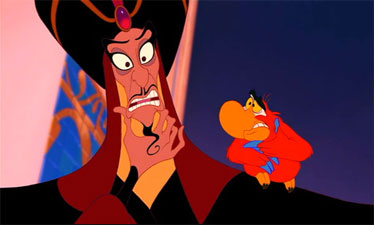
Ultimately, Aladdin works because the viewer genuinely cares about the characters on the screen. Although Aladdin and Abu are street thieves, they steal so they can eat and they are even willing to give to others that need it more (i.e. the children in the beginning). We can sympathize with Jasmine’s desire to marry for love, and with the Genie who wants to be free from the lamp. We care so much for these characters that when they are wronged, we feel sad, such as when Genie finds out Aladdin is going to use his third wish on himself. The ending is an incredible moment that always brings tears to my eyes. The movie has some great visuals including the memorable escape from the Cave of Wonders and the beginning with its stunning view of Agrabah and the palace. The music takes the animation to a different level of appreciation with its memorable songs and score. Much has been said about this movie playing to both adults and children, and it is true that both groups can enjoy this movie together. The film is filled with humor, drama, and romance that target every segment of the viewing public. It is a fabulous story that is worthy of all the praise it has gotten over the years.
Is This Thing Loaded?
The Aladdin: Platinum Edition is split up into two discs, with the first disc holding the movie and a few special features, and the second disc holding the bulk of the special features. Both discs feature an index where you can find all of the features in one place.
Disc One: On the first disc are a few bonus features such as music and deleted scenes. This is apart from the Trailers menu which features trailers for the Aladdin Trilogy, Bambi, Pooh’s Heffalump Movie, Mulan: Special Edition, Mary Poppins: 40th Anniversary Edition, Mulan II, Jetix, the Make-a-Wish (foundation narrated by Genie), and the Disneyland Resort. Disc One also features a preview for Disc Two.
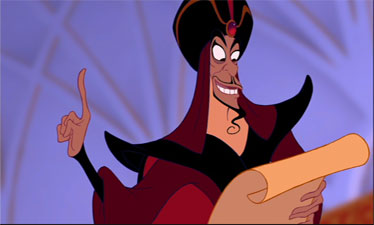
The Bonus Features Menu is split up into four parts: Deleted Songs, Deleted Scenes, Music & More, and Backstage Disney. In Deleted Songs, you will find four songs that were deleted from the original film in the development process. “Proud of You” was written by Menken and Ashman and is about Aladdin apologizing to his mother and singing about one day making her proud of him. It is a heartfelt song that is sung by Clay Aiken in another part of the disc. “You Can Count on Me”, written by Menken, is Aladdin’s original “I want” song. “Humiliate the Boy” was Howard Ashman’s last song and was supposed to be played when Jafar unveiled Aladdin’s secret identity in the original story. Finally, “Why Me”, written by Menken and Rice, features Jafar complaining about his role under the Sultan. All of these songs are accompanied by original storyboards from the development stage, and are introduced by Menken. The Deleted Scenes feature “Aladdin & Jasmine’s First Meeting” where Clemens and Musker introduce a storyboard reel featuring a younger Aladdin meeting Jasmine in her garden. The second scene is “Aladdin In the Lap of Luxury” which existed when Aladdin still had a mother and he finds out his mother is not proud of his behavior towards Genie.
The “Music & More” section features Disney’s Song Selection where you can play the songs from the movie with the lyrics on the screen like a sing-along. There are also Music Videos for “Proud of Your Boy” by Clay Aiken (which is actually not that bad), “A Whole New World” sung by Nick Lachey and Jessica Simpson, and the original “A Whole New World” sung by Peabo Bryson and Regina Belle. The two new videos feature a Behind-the-Scenes of the Music Video feature (which seems like overkill to me). The final part of the first disc is “Backstage Disney” which is where the viewer will find the audio commentaries. There is a Filmmaker’s Audio Commentary by John Musker, Ron Clemens, and Amy Pell, and an Animator’s Audio Commentary featuring Andreas Deja (Jafar), Will Finn (Iago), Eric Goldberg (Genie) and Glen Keane (Aladdin). Another feature in this area is a “Pop Up Fun Facts” which are subtitles that appear throughout the movie with interesting facts and trivia about the movie.

Disc Two: Disc Two is divided into two different areas: Games & Activities and Backstage Disney. In the Games & Activities section, there are four different activities which are aimed at kids (in line with previous Platinum Editions). First up is “Aladdin’s Magic Carpet Adventure: A Disney Virtual DVD Ride” which is a 3D game in Agrabah featuring Timon (taking over for the Genie). We get on the carpet and ride through the streets with Aladdin. Here, one finds clues to rescue Jasmine. This ride features characters from other Disney movies like Stitch. I had some trouble with some clues, but I’m sure that smaller children will get them. These carpet rides between places are like roller coaster rides, but they take a while, so the player can skip the actual rides. Although I managed to lose at all but one of the tasks, I somehow managed to save Princess Jasmine in the end after all. Go figure. The second activity is “Inside the Genie’s Lamp” (Guided and Self-Guided Tour) were we get a glimpse of the Lamp’s Garden, Bedroom, Dining Room, Spa, and Kitchen. This is actually a boring tour with few highlights. Note that the guided and unguided tours feature different things. On the guided tour, Iago goes into the lamp and is guided by the voice of the lamp. The “3 Wishes Game: Your Fortune Revealed” is a strange game where Iago narrates the action and we play a pinball-style game to get balls into Jafar’s mouth as it moves open and shut. If you get it in, Jafar “grants” your wish. Finally, there’s “The Genie World Tour” where you see postcards of Genie in different parts of the world. Basically, kids will like this part of the DVD, but adults could skip it.
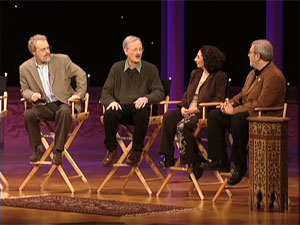
The “Backstage Disney” is separated into four parts. The first one is “A Diamond in the Rough: The Making of Aladdin” and this is the bulk of the disc. In this section, you have three options of how to watch the content. You can use the “Play All” feature, you can access the index to view all videos one at a time, or you can watch the main feature (an interview Leonard Maltin has with the people involved in the movie) with breaks to select smaller videos you want to watch. The navigation of the menu is divided into four parts: the Creators & Producers, The Music, The Animators, and The Voice Talent. If you chose the “As You Wish” option, you will be treated to Leonard Maltin’s interview, which takes place at the Hyperion Theater in front of an audience of CalArts students.
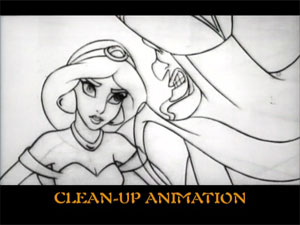
The first part is “An Evening With The Creators Of Aladdin‘s Lamp; The Producers” (11:55) featuring John Musker, Ron Clemens, and Amy Pell, which is followed by videos relating to development: “From Arabian Nights to the Silver Screen” (2:45), “Reflections on Black Friday” (3:25), “Keane’s Team: Redesigning the Lead Character” (4:30), “Rought Stuff #1: Progression Reel (1:53), “Rough Stuff #2: An Animator Checks His Work” (1:10), and “Green Room/ Take 1” (1:35). The Green Room segments are segments featuring Gilbert Gottfriend commenting backstage and interviewing people. The second part is “The Music” (6:50) where Maltin interviews Alan Menken. This is followed by “A Whole New World: The Recording Sessions” (4:25), “Rough Stuff #3: Prince Ali: Work in Progress” (1:05), and “Green Room/ Take 2” (1:10). The third part is “The Animators” (13:30) where Maltin interviews Andreas Deja, Randy Carlwright, Will Finn, and Eric Goldberg. This is followed by “Pencil + Computer: Creating the Magic Carpet” (3:10), “Master of the Line: The Art of Al Hirschfeld” (4:30), “Designing Jasmine” (2:40), “Designing Jafar” (2:10), “Unsung Heroes Of the Clean-Up Department” (2:25), “Jafar Goes to the Birds” (3:10), “Rough Stuff #4: When Live Action Meets Animation” (2:40), and “Green Room/ Take 3” (2:10). Finally, the last part of the interview, “The Voice Talent” (6:30) is between Maltin, Scott Weinger (Aladdin), and Gilbert Gottfried (Iago). This is followed by “You Talkin’ to Me?: The Voices of Aladdin” (10:00), “Gilbert Gottfried: Up Close and Aggravated” (2:25), “Behind the Microphone” (1:50), “Extended Cast Member Interviews” with “Scott Weinger” (1:25), “Linda Larkin” (1:45), “Douglas Seale” (1:35), and “Jonathan Freeman” (2:00), and finally “Green Room/ Take 4” (1:10). This is all topped off with “Made You Look” (3:45) which wraps up the interview. Overall, this is everything you wanted to know about the making of Aladdin, so highly recommended. If you don’t have time, use the “As You Wish” option.

Two other areas of the Bonus Features on the second disc are a tribute/documentary about Alan Menken appropriately entitled “Alan Menken: Musical Renaissance Man” (20:00). This is an entertaining and informative documentary that chronicles his life and career at Disney. It was great to see in videos how much Menken and Ashman worked well together. Another interesting part of the DVD features Publicity from the movie. This includes the Original Theatrical Trailer (2:55), the Original Trailer for Aladdin and the King of Thieves (1:30), and the Original Trailer for The Return of Jafar (0:30). There is also a publicity gallery featuring 3 theatrical posters (one in Japanese), 10 unused poster concepts, and pictures from the different theme parks (Paris Disney, Disney World, etc…).
The only other section in the DVD is “The Art of Aladdin” which is recommended for anyone who loved the art as much as I did. First up is “Art Review: With Filmmaker’s Commentary” (8:45) where the filmmakers give a general overview of the art. Here John Musker and Ron Clemens talk about the visual inspirations, drawings, and paintings made for the film. They talk about the thousands of drawings that didn’t make it into the film and what was already there when they joined the project. This commentary is really helpful to understanding the color schemes used in the movie and the designs of the characters. There are also still frame galleries featuring menus for Visual Deveopment, Story Development, Background & Color Key, and Character Development. The Character Development section features galleries for Aladdin, Jasmine, Genie, Jafar, Iago, Abu, Sultan, Rajah, The Lamp (it once had a face), Narrator, Carpet, Guards & Thieves, Marketplace, Aladdin’s Parents (deleted), Executioner (deleted) and Model Sheets. What I originally did in this art section is that I looked through the gallery before listening to the commentary, which was the wrong way to go about this. Unlike in previous Platinum Editions, Aladdin does not feature individual commentaries for the art. I was upset at first, but I think that this format (with the separate commentary) is actually better in getting people to learn about the art in one place.
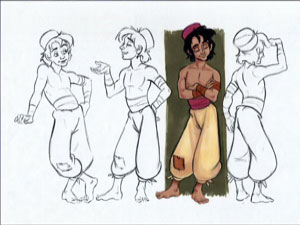
Okay, I was impressed with the bonus features in this release, and was particularly excited about the “Play All” function. Unlike the Beauty & the Beast DVD, this actually played all the items in the menu. In terms of organization, this might be the best Platinum Edition. Another improvement was the separate video commentary about the art of Aladdin. This might encourage more people to learn about the art and then browse through the gallery. I did feel that there were some things missing from the art gallery. After all, there were thousands of pictures NOT used in the movie. Some of the character galleries were rather bare and felt like they could’ve shown the development of the characters in more depth. I didn’t see the need to have a new version of “A Whole New World”, but at least the Lachey/Simpson duo was better than some of the teen pop version of songs we have seen in previous releases (I shudder at what could have been).
Case Study:
Aladdin is perfectly in line with the previous two releases in Disney’s Platinum Edition line. There is an outer cardboard slipcover with a reveal that highlights the special features on the set. Inside, is a standard black Amaray keepcase holding the two discs. The DVD comes with three booklets. One is an excellent DVD Guide with in-depth information on the special features of the DVD as well as a navigation map for the release. There is also a thick coupon book that comes with a mini storybook with the story of The Return of Jafar and Aladdin And The King Of Thieves. Finally, there is a form available for the Aladdin Video and DVD Sweepstakes to win a vacation to Disneyland Resort.
For those true fans of the movie, Disney has also released a Collector’s Gift Set that in addition to the DVD comes with signed animator’s sketches, a film cell, and a hardcover book.

Ink And Paint:
This is the first time we see Aladdin in fully digital form, which is great because it is such a beautiful movie. I looked hard for specs and dust or any fragments in the picture, but could not find anything. The picture is practically spotless, and some details were added to some scenes and backgrounds (this was supposed to be released on IMAX screens). It is good to note that the detail was added with the supervision of the original creative team. From the opening credits in the desert to the Cave of Wonders, the film looks amazing. The CG elements, which improved upon those found in Beauty & The Beast, don’t look as sophisticated as they do nowadays, but they still have the same effect. The carpet ride still thrills the viewer like a roller coast ride. The backgrounds and art look incredible in its original 1.66:1 aspect ratio which has only been previously been enjoyed on laserdisc.
Scratch Tracks:
Aladdin is featured in four different audio tracks including an English 5.1 Enhanced Home Theater Mix, and Dolby Digital 5.1 Surround Sound in English, French, and Spanish tracks. The new theater mix is comparable to The Lion King release that came out last year. All 5.1 tracks are really good with the Academy Awarded nominated sound effects noticeable in many scenes such as the opening with the narrator and in the cave of wonders. The score also really comes through directly bringing up to the action on the screen. Disney purists might want to know that there have been changes made to the track since the original theatrical release. The change on the “Arabian Nights” lyrics still stands from the video release. “Where they cut of your hand if they don’t like your face” is still replaced by “Where it’s flat and immense and the heat is intense”. This was a change made after Arab-American groups complained about the lyrics (but not about the other stereotypes in the story). Another infamous line in a scene where Aladdin tells Rajah to stay away (which some people understood as Aladdin saying something suggestive) has also been replaced for this version with “down kitty.” There are also English captions for the hearing impaired.

Final Cut:
Did I already mention I am thrilled to finally see this movie on DVD? I don’t need to tell you that I think this is one of the best animated films of all time. It is a magical and entertaining experience for people of all ages. Some people may be disappointed with one or two aspects of the bonus features, but I have to admit that it met my expectations. I wanted to watch a thorough making-of documentary, and I think that the second disc delivers just that. They could’ve added more art in the art galleries, but overall it was a great Platinum Edition. With perfect sound, video, and a great story, this is probably one of the best releases of the year. For hardcore fans, there is also a Collector’s Edition that includes all-new sketches from the original animators, collectible still frames from the movie, and a DVD companion book. I personally don’t have that version…yet, but feel free to share you thoughts on it in our message board.
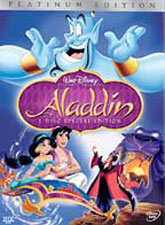 | ||
 |







